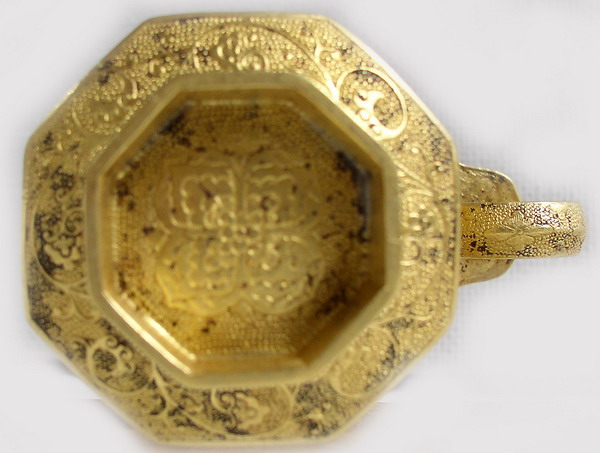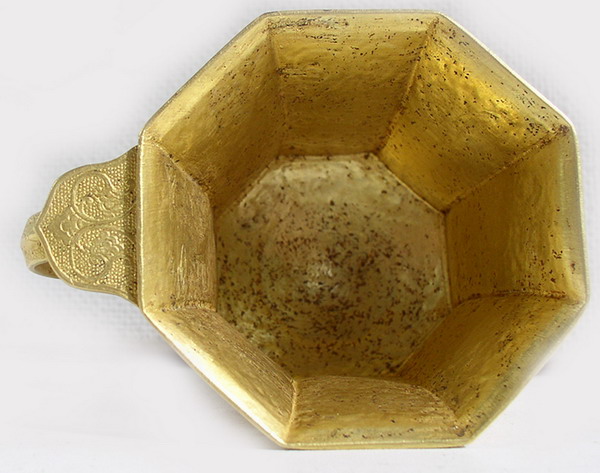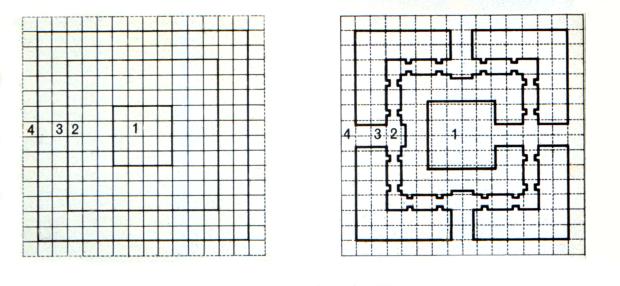
|
Subject:Re: Re: Re: Chinese gold cup 18th century
Posted By: njg Wed, Nov 23, 2005
The Sogdian Colony in Dunhuang.
The Han sources reporting on Inner Asia make particular note of the trading acumen of Sogdians, the ethnically Iranian merchants from Transoxiana. There is abundant evidence in documents, histories and petroglyphs that their trading activities from their homeland stretched as far as Luoyang (the "eastern" capital of China), north into Mongolia, and down into what today is Pakistan via the Hunza Valley. They were active on both the northern and southern branches of the Silk Road around the Tarim Basin. the chronological range of the evidence about the Soghdians in the East is from around the third century BCE to the eighth century CE. It should be no surprise that there seems to have been a sizeable colony of Sogdians at Dunhuang, dating from at least the early fourth century, when it probably numbered as many as 1000. Even on the eve of the Soghdians' dispersion or absorption into the local population in the mid-eighth century, they numbered some 300 households with an estimated 1400 individuals. It appears that the colony had increased in the early seventh century due to recent arrivals from Trasoxiana, since many of the residents have both Turkic and Sogdian names.
During much of their time in Dunhuang, the Sogdians seem to have been occupied largely in trade-related activities--either as agents in a network of Sogdian merchants or connected with the administration of trade and foreign merchants. The fourth century documents make it clear that they had direct contacts with Samarkand, and there is at least indirect evidence they probably had direct involvement with the trade south to India. Sims-Williams postulates a "triangle" of trade, where one side was the Tarim Basin route, a second the north Pakistan one, and the third from north Pakistan back to Transoxiana. the existence of such connections would help to explain why in the mid-5th century, a Chinese ambassador on his way to Samarkand traveled via the Hunza Valley, where he left an inscription on the Rock of Hunza. The early documents are fragmentary and clearly do not mention all the products of interest for this trade (notably, silk is absent), but among those that are listed are gold, musk, pepper, camphor, cloth of hemp or flax, and wheat
During much of their time in Dunhuang, the Sogdians seem to have been occupied largely in trade-related activities--either as agents in a network of Sogdian merchants or connected with the administration of trade and foreign merchants. The fourth century documents make it clear that they had direct contacts with Samarkand, and there is at least indirect evidence they probably had direct involvement with the trade south to India. Sims-Williams postulates a "triangle" of trade, where one side was the Tarim Basin route, a second the north Pakistan one, and the third from north Pakistan back to Transoxiana. the existence of such connections would help to explain why in the mid-5th century, a Chinese ambassador on his way to Samarkand traveled via the Hunza Valley, where he left an inscription on the Rock of Hunza. The early documents are fragmentary and clearly do not mention all the products of interest for this trade (notably, silk is absent), but among those that are listed are gold, musk, pepper, camphor, cloth of hemp or flax, and wheat
The Sogdians by the late 8th century were assimilated into the Chinese households.
Nick


|
 Chinese gold cup 18th century
Chinese gold cup 18th century  ( China & Japan ) - Tom - Nov 07, 2005 (12:40 PM)
( China & Japan ) - Tom - Nov 07, 2005 (12:40 PM)  Re: Chinese gold cup 18th century - Edward Shumaker - Nov 13, 2005 (01:07 PM)
Re: Chinese gold cup 18th century - Edward Shumaker - Nov 13, 2005 (01:07 PM)  Re: Re: Chinese gold cup 18th century - nj - Nov 23, 2005 (05:52 AM)
Re: Re: Chinese gold cup 18th century - nj - Nov 23, 2005 (05:52 AM)  Re: Re: Re: Chinese gold cup 18th century - njg - Nov 23, 2005 (06:28 AM)
Re: Re: Re: Chinese gold cup 18th century - njg - Nov 23, 2005 (06:28 AM)  Re: Re: Re: Re: Chinese gold cup 18th century - nj - Nov 26, 2005 (10:07 AM)
Re: Re: Re: Re: Chinese gold cup 18th century - nj - Nov 26, 2005 (10:07 AM)  Re: Re: Re: Re: Re: Chinese gold cup 18th century
Re: Re: Re: Re: Re: Chinese gold cup 18th century  - pierrevdw - Nov 26, 2005 (09:09 PM)
- pierrevdw - Nov 26, 2005 (09:09 PM)  Re: Re: Re: Re: Re: Re: Chinese gold cup 18th century - nj - Nov 27, 2005 (03:24 AM)
Re: Re: Re: Re: Re: Re: Chinese gold cup 18th century - nj - Nov 27, 2005 (03:24 AM)  Re: Re: Re: Re: Re: Re: Re: Chinese gold cup 18th century
Re: Re: Re: Re: Re: Re: Re: Chinese gold cup 18th century  - pierrevdw - Nov 27, 2005 (08:44 AM)
- pierrevdw - Nov 27, 2005 (08:44 AM)  Chinese gold cup 18th century
Chinese gold cup 18th century  - Tom - Nov 27, 2005 (09:18 AM)
- Tom - Nov 27, 2005 (09:18 AM)  Re: Chinese gold cup 18th century - pierrevdw - Nov 28, 2005 (12:38 AM)
Re: Chinese gold cup 18th century - pierrevdw - Nov 28, 2005 (12:38 AM)  Re: Re: Chinese gold cup 18th century - njg - Nov 28, 2005 (09:00 AM)
Re: Re: Chinese gold cup 18th century - njg - Nov 28, 2005 (09:00 AM)  Re: Re: Re: Chinese gold cup 18th century - njg - Nov 28, 2005 (09:56 AM)
Re: Re: Re: Chinese gold cup 18th century - njg - Nov 28, 2005 (09:56 AM)  Re: Re: Re: Re: Chinese gold cup 18th century
Re: Re: Re: Re: Chinese gold cup 18th century  - nj - Nov 28, 2005 (10:03 AM)
- nj - Nov 28, 2005 (10:03 AM)  Re: Re: Re: Re: Re: Chinese gold cup 18th century
Re: Re: Re: Re: Re: Chinese gold cup 18th century  - njg - Nov 28, 2005 (10:25 AM)
- njg - Nov 28, 2005 (10:25 AM)  Re: Re: Re: Re: Re: Re: Chinese gold cup 18th century - Edward Shumaker - Nov 28, 2005 (05:31 PM)
Re: Re: Re: Re: Re: Re: Chinese gold cup 18th century - Edward Shumaker - Nov 28, 2005 (05:31 PM)  Re: Chinese gold cup 18th century - nj - Nov 29, 2005 (05:01 PM)
Re: Chinese gold cup 18th century - nj - Nov 29, 2005 (05:01 PM)  Re: Chinese gold cup 18th century - Edward Shumaker - Nov 29, 2005 (06:07 PM)
Re: Chinese gold cup 18th century - Edward Shumaker - Nov 29, 2005 (06:07 PM)  Re: Chinese gold cup 18th century - nj - Nov 29, 2005 (07:10 PM)
Re: Chinese gold cup 18th century - nj - Nov 29, 2005 (07:10 PM)  Re: Re: Re: Re: Re: Re: Re: Re: Re: Re: Chinese gold cup 18th century - njg - Nov 29, 2005 (09:31 PM)
Re: Re: Re: Re: Re: Re: Re: Re: Re: Re: Chinese gold cup 18th century - njg - Nov 29, 2005 (09:31 PM)  Re: Re: Re: Re: Re: Re: Re: Re: Re: Re: Re: Chinese gold cup 18th century - njg - Nov 30, 2005 (02:31 AM)
Re: Re: Re: Re: Re: Re: Re: Re: Re: Re: Re: Chinese gold cup 18th century - njg - Nov 30, 2005 (02:31 AM)  Re: Re: Re: Re: Re: Re: Re: Re: Re: Re: Re: Re: Chinese gold cup 18th century
Re: Re: Re: Re: Re: Re: Re: Re: Re: Re: Re: Re: Chinese gold cup 18th century  - njg - Dec 02, 2005 (04:03 AM)
- njg - Dec 02, 2005 (04:03 AM)  Re: Re: Re: Re: Re: Re: Re: Re: Re: Re: Re: Re: Re: Chinese gold cup 18th century - njg - Dec 03, 2005 (02:00 PM)
Re: Re: Re: Re: Re: Re: Re: Re: Re: Re: Re: Re: Re: Chinese gold cup 18th century - njg - Dec 03, 2005 (02:00 PM)  Re: Chinese gold cup 18th century - njg - Dec 08, 2005 (12:28 PM)
Re: Chinese gold cup 18th century - njg - Dec 08, 2005 (12:28 PM)  Re: Chinese gold cup 18th century
Re: Chinese gold cup 18th century  - Aarre - Dec 21, 2014 (05:10 PM)
- Aarre - Dec 21, 2014 (05:10 PM) 






